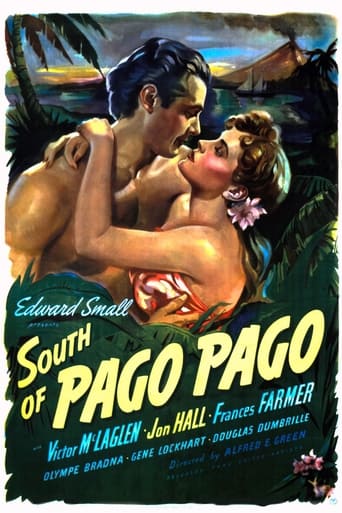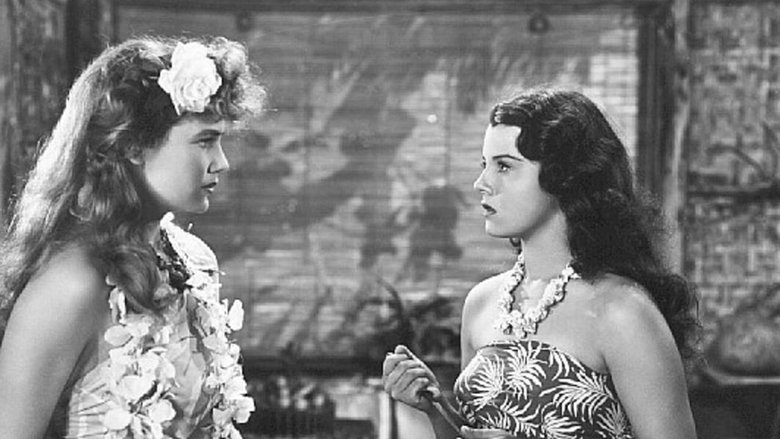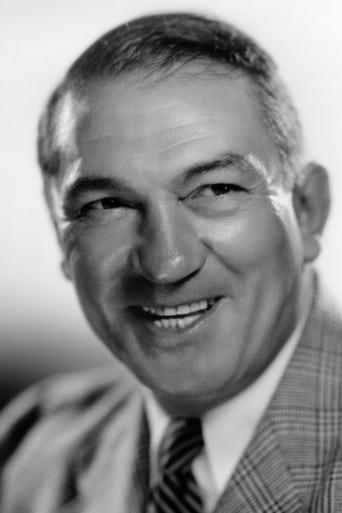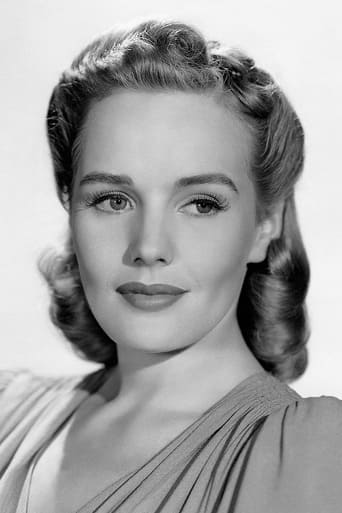

South of Pago Pago (1940)
Sent by cutthroat pirates to turn Kehane’s head while they loot his island paradise of a fortune in pearls, Ruby instead falls for the young chief. Together, the two save Kehane’s people and their island home from the rapacious picaroons but at the tragic cost of their own future together.
Watch Trailer
Cast
Reviews
I wanted to like it more than I actually did... But much of the humor totally escaped me and I walked out only mildly impressed.
A movie that not only functions as a solid scarefest but a razor-sharp satire.
It’s not bad or unwatchable but despite the amplitude of the spectacle, the end result is underwhelming.
An old-fashioned movie made with new-fashioned finesse.
Presented by Edward Small. Released through United Artists. Copyright 25 July 1940 by Edward Small Productions, Inc. New York release at Radio City Music Hall: 1 August 1940. U.S. release: 19 July 1940. U.K. release: 23 September 1940. Australian release: 28 October 1940. Sydney release at the Plaza: 25 October 1940. 8,776 feet. 97½ minutes.SYNOPSIS: Bad white mens steal-um natives' pearls.NOTES: Pago-Pago is pronounced "Pango-Pango". There is no hyphen in the film's actual credit titles. Grant Whytock who is billed as assistant to the producer is the veteran film editor whose career stretches from The Four Horsemen of the Apocalypse (1921) to The Christine Jorgensen Story (1970). Presumably he acted as supervising film editor.COMMENT: Although enthusiastically acted and produced on a comparatively expensive budget, South of Pago Pago tends to outstay its welcome. Chief drawback is the conventional script. The plot (with some unintentionally laughable dialogue: "Why don't you stop it? Haven't you killed enough people already?" - "Ha-ha-ha! Now I'm the boss of Manoa!") follows nothing if not a predictable course.What makes the film worth watching are its performances: Frances Farmer tossing off wiseacre lines like a junior Mae West, Victor McLaglen leading and laughing it up villainously, Douglass Dumbrille flashing his eyes with ominous relish and articulating even his most innocent lines chock-full of menace, Abner Biberman - a thief in the clutch of pirates - lapping through his second-string, dirty-dozen act. As usual, the villains are best served, though Jon Hall looks and acts appropriately dumb as the innocent native chieftain.Alas, it all takes too long to reach the foregone action climax in which the villains get their just desserts. Spectacularly staged as it is, some very obvious use of models and miniatures lessens its impact (the camera shooting down on the model canoes from too high an angle is an elementary mistake). Nonetheless, some exciting falls and stuntwork - though another fault which rather dates all the action spots is the over-use of speeded-up motion.Mescall's photography is at its richest and most atmospheric in some of the studio scenes - the opening in the vast, smoky, gin-sling waterfront dive, the ship-board climax - despite many obvious camera set-ups against a process screen. Actually, much of the film was lensed on location - here the photography is pretty ordinary - and producer Small has also footed the expense of using a real, fully-rigged sailing ship.Green's direction has a smidgen more style than usual in his forties' offerings - the compositions are tighter (once or twice even imaginative) and the camera set-ups more varied. Sets and costumes sometimes appeal. The music score (including the title song) has the right South Seas synthetic atmosphere.Of course, for modern audiences South of Pago Pago has an irresistible secondary appeal; the opportunity to see the legendary Frances Farmer in a role which, if not exactly typical, she certainly plays to the hilt.
SOUTH OF PAGO PAGO (United Artists, 1940), an Edward Small Presentation, directed by Alfred E. Green, is a South Seas adventure tale starring Victor McLaglen, Jon Hall and Frances Farmer in the leads. As much as this movie might have started a trend of other South Seas adventures that were common ground during the 1940s, with many produced in lavish Technicolor, this is not the first of this cycle. In 1937 alone, Jon Hall got his first big break in a leading role opposite sarong girl Dorothy Lamour in THE HURRICANE (Samuel Goldwyn) while Frances Farmer was featured in a Technicolor adventure of EBB TIDE (Paramount), based on the novel by Robert Louis Stevenson. Three years later, their paths would meet for this black and white adventure tale with enough island scenery that might have been more effective had it been produced in Technicolor.Opening title: "This is a story of days not so long ago, when Singapore spawned a race of steel-fisted, iron-jawed adventurers, who lived happy, fought hard and died hard - as they ravaged unknown seas, lured by the priceless lusture of virgin pearls." Opening in Shanghai, China, at the Tingle Tangle Café, hostess Ruby Taylor (Frances Farmer) meets with Portuguese sailor, Manuel Forro (Abner Biberman) with news about rich pearl beds that can be found off the shores of Manoa. This news reaches Ruby's friends, Captain Bucko Larson (Victor McLaglen) and his first mate, Williams (Douglass Dumbrille), who invite both Ruby and Manuel aboard their steamer, the L.A. Dessa, bound for the island south of Pago Pago. Before reaching Manoa, Manuel, who's upset about being cheated of his promised share, is thrown overboard to the sharks by Bucko. Greeted by the natives, the crew is met by Kehase (Jon Hall), son of the island chief (Pedro De Cordoba). Although loved by Malia (Olympe Branda) since childhood, Kehase takes an immediate interest in Ruby, a beautiful white woman. Also on the island is Mr. Lindsay (Gene Lockhart), a white man who's been living among the natives for nine years, is not please by the presence by these visitors, which may mean trouble for his happy paradise. His instincts are correct. As the native boys dive for pearls, danger lurks for some, leading to certain deaths or injuries. Kehase insists the pearl diving must stop. Not wanting to leave the island with just twelve pearls to their name, Bucko uses Ruby to lure Kehase away, even to a point of marrying him and honeymooning on the island of Tua Tua. With Kehase temporarily out of the way, Bucko and his mates resume their greedy force amongst the native boys, risking their lives diving for more pearls and turning a once happy community into a fearful one. Also seen in the cast are: Francis Ford (Foster); Ben Weldon (Grimes); and Harry Woods (Black Mike Rafferty).A South Seas tale that plays like a Saturday afternoon matinee is one that has done no harm in Jon Hall's movie career, considering a handful of similar adventures that would follow later on, especially those six over at Universal opposite the exotic Maria Montez. Hall does well as the island leader, but his accented manner of talking fails to come off convincingly. Aside from native drum playing and dancing, shipboard fights pearl diving dangers, the movie also contains off-screen chanting and singing to the title tune of "South of Pago Pago" by Chet Forrest, Bob Wright and Frank Loesser to round out the story. When Frances Farmer makes her first screen entrance in the cafe, her character, clothes and hairstyle strongly resemble that of her Lotta character from her breakthrough film, COME AND GET IT (1936). Once the story shifts towards the island of Manoa, she not only lets her hair down, figuratively, she appears slightly heavier in her physical appearance than before. Olympe Bradna, on loan from Paramount, makes a beautiful island girl. She even participates in a lively island dance with Jon Hall.Not as well known as other films of this type, SOUTH OF PAGO PAGO did become available on VHS through VCI Home Video around 1998, and later onto DVD, assuring its rediscovery. Though cable television broadcasts are uncertain, it was once popular viewing on the late show or afternoon broadcasts during the 1960s and 1970s before taken out or circulation. Overlooking certain outdoor scenes that appear more indoor studio bound, with ordinary scripting, SOUTH OF PAGO PAGO moves swiftly during its 97 minutes of action and adventure. (*** pearls)
Exotic looking adventure of pearl divers in this south seas working for the ruthless Victor McLaglen and the sinister actions of the visiting captain vs. the noble natives. Much of the film focuses on young lovers Jon hall and Olympe Bradne's love being interrupted by the "cloud color skinned" Frances Farmer, a sensual traveler on McLaglen's ship. The peaceful island sees it's first outbursts of violence as the greedy crew under McLaglen turns their world upside down, reminding me of what the native Americans must have thought by the actions of certain Europeans, "Uh oh, there goes the neighborhood!"About as realistic as a Cecil B. DeMille religious epic when it comes to casting, this has to be viewed outside of standard smarts and taken for the delicious, often campy fluff, it is. Hollywood seemed to view native islanders as happy go lucky, friendly hard workers who welcomed visitors without suspicion, and worked hard enough to keep a fresh supply of fish, tropical fruits and sarong materials so they could spend the bulk of the day making love. Every island spot is another example of paradise and every day brings on a new adventure. Bradne's love for Hall is viewed as a juvenile crush after Farmer arrives, and the island elders all speak in wise clichés that the young take seriously without objection. There's no conflict in their life until the arrival of the evil white man. Yet, in spite of all that silliness, there's a bit of a "Lost Horizon" inside this world, an analogy of a peaceful world being interrupted by the arrival of a ruthless leader. Taking into account what was going on in Europe at the time, I'm sure that movie audiences immediately got the connection. This is wisdom disguised in a fluffy, simplistic manner, and I can see the audiences taken in by the moral of the story as well as the beauty. Nearly 80 years later, that message remains as potent as ever, reminding us too of threats of the loss of natural resources and the obsession of wealth and power. Pearls of wisdom a-plenty in this timeless tale.
I can't express how fortiesishly luscious this is on every level. Any fan of that era who hasn't seen it 'ain't there yet.' Frances Farmer ! How could you describe her? [a curiously unblemished saloon girl in this one, but what the heck?] John Hall ! Victor McLaglen ! These people - who they were in the time in which they lived and worked - bigger & more beautiful than life - a part of that never-never fantasy world - that was so much illusion - once lived and so gone forever - of the forties.


